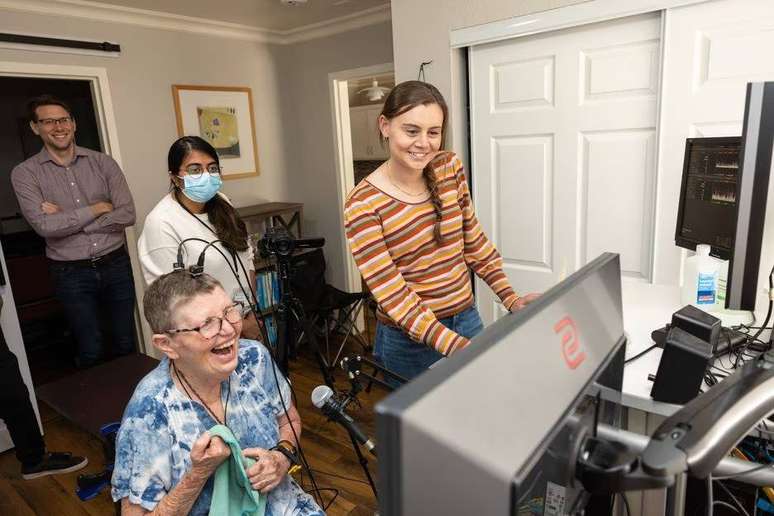American scientists have developed technologies that can quickly translate brain signals into words
html[data-range=”xlarge”] figure image img.img-f8a52d2b5de35311d64aedef49e167c6shv0xjkx { width: 774px; height: 516px; }HTML[data-range=”large”] figure image img.img-f8a52d2b5de35311d64aedef49e167c6shv0xjkx { width: 548px; height: 365px; }HTML[data-range=”small”] figure image img.img-f8a52d2b5de35311d64aedef49e167c6shv0xjkx, html[data-range=”medium”] figure image img.img-f8a52d2b5de35311d64aedef49e167c6shv0xjkx { width: 564px; height: 376px; }HTML[data-range=”small”] .article__image-embed, html[data-range=”medium”] .article__image-embed {width: 564px; margin: auto 0 30px; }
American scientists have developed technologies capable of translating the brain signals of people who cannot speak into words very quickly, according to two studies published Thursday 24 in the journal nature.
Pat Bennett, 68, who suffers from amyotrophic lateral sclerosis (ALS) has been testing the technology and says it will help her stay connected to the world. Electrodes implanted in his brain decode the words he wants to say.
Technology can be critical for people who can’t speak because they’ve had a stroke, brain disease or paralysis. They can communicate their thoughts in real time.
Before being diagnosed with ALS, Pat Bennett rode and ran every day. The disease, identified in 2012, affects areas of the brain that control movement, resulting in paralysis. The word was the first thing to be hit.
Although her brain’s ability to generate speech has not been impaired, the muscles in her mouth, tongue, voice box and jaw are paralyzed and do not allow her to speak.
To carry out the research, a surgeon implanted four pill-sized sensors in Pat’s brain, specifically in the areas responsible for language. When these brain regions send commands to the mouth and jaw to make sounds and form words, an algorithm decodes the information.
“The system is trained to know which words should precede each other and the phonemes used in each one,” said Frank Willett of Stanford University, co-author of the study, adding that the technology can translate three out of four words correctly. “Even if something is misinterpreted, it’s still a good guess.”
“For those who don’t talk, this means they can stay connected to the world, maybe continue working, maintain friends and family relationships,” Willet said in a news release.

Faustão’s heart transplant costs R$37,000 per SUS
After four months of training Pat Bennett’s speech-interpreting software, his brain activity began to be translated into words on a screen at a rate of 62 words per minute. According to scientists, a normal conversation can reach 160 words per minute and the goal now is to be able to adapt the technology so that it can be used in everyday life.
In another study, conducted by the University of California at San Francisco, Ann Johnson, who was severely paralyzed after a stroke, was able to speak through a digital avatar that could even reproduce her facial expressions.
Scientists detected signals from more than 250 electrodes implanted in the patient’s brain and used an algorithm to recreate her voice based on a recording of a speech she gave at her wedding. The system achieved about 80 wpm and made few errors.
“I felt like a whole person again,” Ann told the paper. The New York Times.
To work, Johnson’s implant had to be connected via a cable to the computer. But scientists are already working on wireless versions. The researchers hope that people who have lost their speech can converse in real time using computer images of themselves that also convey pitch, inflection and emotions such as joy and anger.
“The technology has the potential, over time, for patients to be able to speak normally in virtually real time,” said Sean Metzger, who helped develop the technology.
Source: Terra
Ben Stock is a lifestyle journalist and author at Gossipify. He writes about topics such as health, wellness, travel, food and home decor. He provides practical advice and inspiration to improve well-being, keeps readers up to date with latest lifestyle news and trends, known for his engaging writing style, in-depth analysis and unique perspectives.









